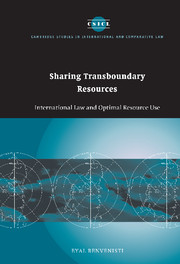Book contents
- Frontmatter
- Contents
- Acknowledgments
- Table of cases
- List of abbreviations
- 1 Introduction
- 2 The need for collective action in the management of transboundary resources
- 3 States as collective actors
- 4 The transnational conflict paradigm: structural failures and responses
- 5 Transnational institutions for transboundary ecosystem management: defining the tasks and the constraints
- 6 The structure and procedure of institutions for transboundary ecosystem management
- 7 The development of positive international law on transboundary ecosystems: a critical analysis
- 8 Efficiency, custom, and the evolution of international law on transboundary resources
- 9 Conclusion
- Bibliograhy
- Index
- CAMBRIDGE STUDIES IN INTERNATIONAL AND COMPARATIVE LAW
8 - Efficiency, custom, and the evolution of international law on transboundary resources
Published online by Cambridge University Press: 14 July 2009
- Frontmatter
- Contents
- Acknowledgments
- Table of cases
- List of abbreviations
- 1 Introduction
- 2 The need for collective action in the management of transboundary resources
- 3 States as collective actors
- 4 The transnational conflict paradigm: structural failures and responses
- 5 Transnational institutions for transboundary ecosystem management: defining the tasks and the constraints
- 6 The structure and procedure of institutions for transboundary ecosystem management
- 7 The development of positive international law on transboundary ecosystems: a critical analysis
- 8 Efficiency, custom, and the evolution of international law on transboundary resources
- 9 Conclusion
- Bibliograhy
- Index
- CAMBRIDGE STUDIES IN INTERNATIONAL AND COMPARATIVE LAW
Summary
Introduction
The previous chapter raised a puzzle. From where did the International Court of Justice (ICJ) draw its authority to reshape the law to the extent that it did in the Gabcikovo–Nagymaros decision? The court did not employ the traditional method of ascertaining the law, namely, a thorough inspection of state practice to trace the evolution of customary law. Nor did it seek the elusive concept of opinio juris to determine which action resulted from the “belief that this practice is rendered obligatory.” Instead, the court took a short-cut by invoking the 1997 Convention on the Law of the Non-Navigational Uses of International Watercourses (“the Watercourses Convention”) as evidence of the development of modern international law – in other words, a reflection of evolving customary law. This was despite the fact that the Watercourses Convention had been adopted less than four months earlier, had no signatories at the time, and its entry into force was far off.
In September 1997, when the Gabcikovo–Nagymaros decision was rendered, state practice and opinio juris were rather precarious stilts to serve as the foundation of modern customary watercourse law. But the Watercourses Convention also stood on shaky ground. Despite having been adopted by a strong majority of 103 states, all were yet to sign the Convention. Even more disturbing, two of the dissenters to the Convention were key regional riparians. China, the upper riparian in the Mekong Basin, refused to join its lower riparians on the Mekong River Commission.
- Type
- Chapter
- Information
- Sharing Transboundary ResourcesInternational Law and Optimal Resource Use, pp. 201 - 231Publisher: Cambridge University PressPrint publication year: 2002



